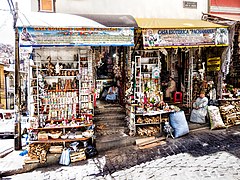
The Witches' Market, also known as El Mercado de las Brujas and La Hechiceria, is a popular tourist attraction located in Cerro Cumbre, a mountain clearing in La Paz, Bolivia. [1] The market is run by local witch doctors known as yatiri , who sell potions, dried frogs, medicinal plants like retama, and armadillos used in Bolivian rituals. [2] The yatiri can be easily identified by their black hats and coca pouches containing amulets, talismans and powders that promise luck, beauty and fertility. [3] Most famous of all the items sold in The Witches' Market are the dried llama fetuses. [4] These llama fetuses are buried under the foundations of many Bolivian houses as a sacred offering to the goddess Pachamama. [5]